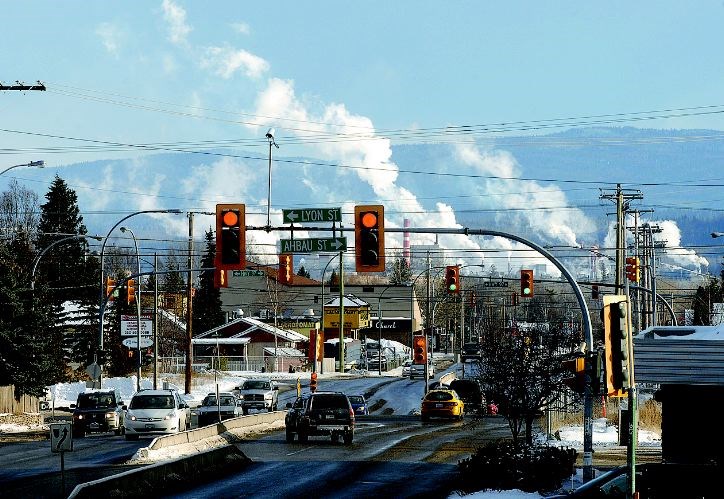w/ side bar: objective of draft plan not new
A long-awaited computer modeling study pinpoints leading fine particulate air pollutant sources in Prince George as road dust, industrial emissions, locomotives, restaurants and residential heating.
Five years in the making and three years overdue, the sophisticated modeling study also shows that reducing all pollutant sources by 40 per cent - an objective adopted by the Prince George Air Improvement Roundtable - will not achieve a 2016 air pollutant level reduction target.
That target - directed at the smallest fine particulate fractions, called PM2.5 - calls for the annual particulate level in the airshed to be reduced to five micrograms per cubic metre, about a one third reductions from the levels in the past decade. (Annual average levels have dropped below seven since 2007).
In order to achieve the target, a 75 per cent reduction of all major sources would be needed, the study concludes.
The conclusions, however, will not stop the air improvement roundtable from moving forward with a draft plan to reduce pollutants levels, said George Stedeford, the outgoing president of the roundtable, who has taken up the vice-presidency.
The plan is to begin acting on the draft plan as quickly as possible, said Stedeford.
The draft air quality management plan calls for targeting reductions in four sectors: industry, commercial, transportation and residential.
The draft plan - available at www.pgairquality.com - is open for public input, and the roundtable has scheduled a public input session for Wednesday, Dec. 8 at the Civic Centre.
For industry - which, for example, includes pulp mills, an oil refinery, sawmills, and asphalt plants - the plan is to reduce fine particulate emissions, including dust, by using and sharing best available technology.
The draft plan also calls for controlling the locations of new industries within the airshed.
UNBC atmospheric scientist Peter Jackson, who presented the modeling findings Tuesday evening at the roundtable's annual general meeting, noted that the pollution sources results will help pinpoint further reductions that will give the most bang for the buck.
It's not necessarily about targeting the biggest sources, but those that have the biggest impact, said Jackson.
Other recommendations of the draft plan includes reducing emissions from restaurants and commercial heating systems, reducing idling at drive-throughs, and reducing dust from sand, gravel and construction sites.
Also on the list are reducing road dust and reducing rail and heavy equipment emissions through technology improvement.
Jackson also noted that the modeling results need further work. For example, it's believed the restaurant emission impacts are too high, and that there is an underestimation of the impact from industry, particularly when winds are from the east.
The work of the roundtable - a diverse group with representatives from the province, city, regional district, Northern Health, UNBC, industry and the public - is tasked with improving air quality in the city as part of a co-operative management process started in the late '90s.
While there has been a reduction in larger fine particles called PM10, there has been no discernible downward trend in smaller fine particles, called PM2.5, since 1998, noted Jackson.
The smaller particles are considered to have the most health impacts as they can be breathed deeply into the lungs.
SIDEBAR
The objectives of the latest air quality improvement plan are not necessarily new.
The B.C. Ministry of Environment has been directing new industrial plants, or others making significant changes, to upgrade pollution control technology.
Asphalt plants have taken steps to reduce emissions, as have some sawmills and pellet plants, including Pacific BioEnergy and Carrier Lumber.
Recently, Lakeland Mills has partnered with the City of Prince George on a district energy system that will include upgraded pollution technology at the sawmill.
Canfor Pulp was just approved for federal funding for a $100 million upgrade at its Northwood pulp mill which will reduce fine particulates and odours.
Three years ago, the environment ministry adopted a policy that stipulates that industrial plants that emit significant levels of fine particulates should be located outside the bowl area encompassing the Nechako and Fraser river valleys. The city and regional district have been working for several years on identifying areas outside of city core to locate new industry.


